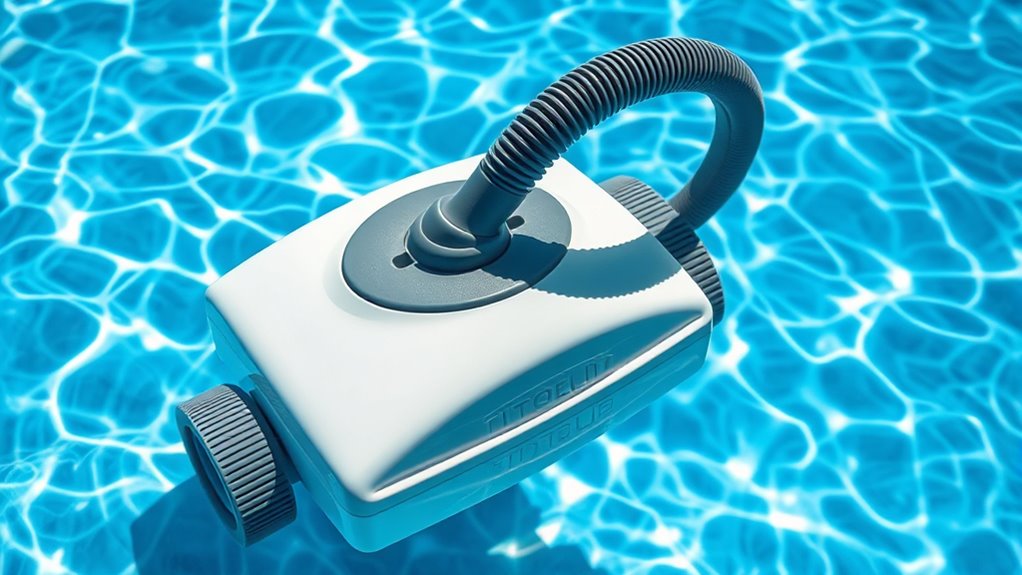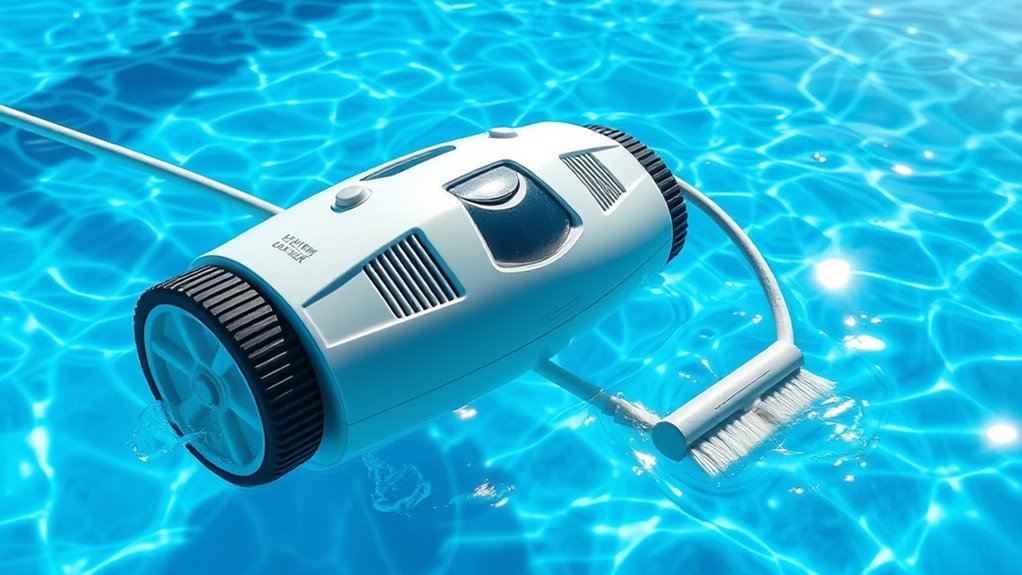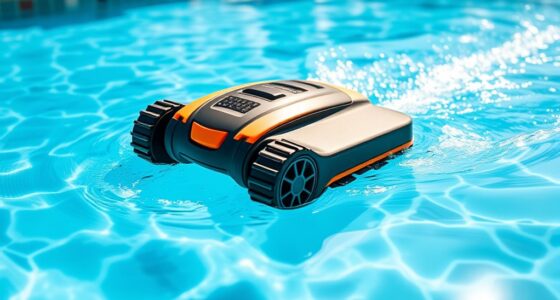To keep your suction pool cleaner working well, check and clean the filter weekly, ensuring no grime or tears. Inspect hoses for cracks or blockages and rinse or replace brushes that have buildup. Regularly examine the motor for unusual noises or corrosion, and maintain all system components per the manufacturer’s instructions. Proper storage during the off-season and early troubleshooting can prevent big issues later. Stay with us to discover more tips for keeping your cleaner in top shape.
Key Takeaways
- Regularly inspect and clean the filter cartridge to ensure optimal water flow and debris pickup.
- Check the hoses for cracks or blockages; clean or replace damaged sections as needed.
- Examine the brushes for algae or debris buildup; rinse or replace to maintain cleaning efficiency.
- Inspect the motor and electrical connections for wear, corrosion, or damage; perform lubrication and replace worn parts.
- Store the cleaner properly during off-season, rinsing all parts and keeping them in a dry, shaded area.

Keeping your suction pool cleaner in top condition is vital for guaranteeing it works efficiently and prolongs its lifespan. Regular maintenance helps prevent breakdowns and keeps your pool crystal clear. One of the most important aspects of upkeep is filter maintenance. Over time, debris, dirt, and algae clog the filter, reducing suction power and making your cleaner work harder. To avoid this, inspect the filter regularly—at least once a week during heavy use. Remove the filter cartridge or basket, rinse it thoroughly with a garden hose, and make certain there’s no buildup of grime. If the filter is torn or excessively dirty, replace it to maintain ideal performance. A clean filter allows for better water flow and guarantees your vacuum picks up debris effectively.
Regularly inspect and clean your filter for optimal suction and cleaner performance.
Alongside filter maintenance, motor inspection plays an essential role in keeping your suction pool cleaner running smoothly. The motor powers the entire cleaning mechanism, so any issues here can considerably impair its operation. Periodically, check the motor for signs of wear or corrosion, especially around electrical connections and the motor shaft. Listen for unusual noises during operation—grinding, squealing, or rattling could indicate a problem. If you notice these sounds, turn off the cleaner and examine the motor. Make sure the wiring is intact and free from damage. Lubricate any moving parts if recommended by the manufacturer, and replace worn-out parts promptly. Regular motor inspection helps catch issues early, preventing costly repairs and guaranteeing consistent cleaning performance. Additionally, keeping your system components well-maintained ensures the entire cleaning process remains efficient and reliable.
Additionally, it’s wise to keep the cleaner’s hoses and brushes in good shape. Check for cracks, blockages, or tangled debris that could restrict water flow. Cleaning the hoses with a hose or replacing damaged sections keeps water moving freely through the system. Brush heads should be free from algae and debris buildup; rinse or replace them as needed. Maintaining these components complements your filter and motor upkeep, guaranteeing every part of your cleaner functions harmoniously. Proper technology and component care are essential for optimal operation. Incorporating robotic technology insights can also help you troubleshoot and enhance your cleaner’s efficiency.
Furthermore, taking advantage of predictive maintenance techniques can help identify potential issues before they become major problems, saving time and money. Finally, always follow the manufacturer’s guidelines for your specific model. Proper storage during the off-season—such as rinsing all parts and storing in a dry, shaded area—further extends the life of your cleaner. By consistently performing filter maintenance, motor inspection, and general component care, you guarantee your suction pool cleaner remains effective season after season. This proactive approach minimizes downtime, saves you money, and keeps your pool sparkling clean with less effort.
Frequently Asked Questions
How Often Should I Replace the Cleaner’S Brushes?
You should replace your suction pool cleaner’s brushes every 6 to 12 months, depending on your cleaning schedule and how often you use the cleaner. Regular brush replacement guarantees ideal cleaning performance and prevents damage to your pool’s surfaces. Keep an eye on wear and tear during routine maintenance, and don’t wait too long to replace brushes, as worn-out brushes can hinder cleaning efficiency.
Can I Use My Suction Cleaner on a Saltwater Pool?
You can use your suction cleaner on a saltwater pool, but check its saltwater compatibility first. Most cleaners are safe, but some parts might corrode over time. verify you use cleaning agents safe for saltwater environments to prevent damage. Regularly rinse your cleaner with fresh water after use, and inspect seals and brushes for corrosion. Doing so keeps your cleaner functioning well and prolongs its lifespan.
What’S the Best Way to Store My Cleaner During Winter?
To guarantee your suction pool cleaner stays in top shape during winter, focus on proper winter storage. First, clean it thoroughly and remove any debris. Store it in a dry, cool place, ideally indoors, to prevent damage from freezing temperatures. If outdoor storage is your only option, make sure to provide outdoor protection like a weatherproof cover. This keeps it protected from harsh elements and prolongs its lifespan.
How Do I Troubleshoot if My Cleaner Isn’T Moving?
You might think your cleaner isn’t moving because of pool algae buildup, but often, a filter clog causes the issue. First, verify the filter isn’t blocked, as debris can restrict suction and movement. Check the hoses for kinks or leaks, and ensure the cleaner’s brushes aren’t stuck. Clearing these obstructions enhances suction, helping your cleaner move smoothly again. Regular maintenance prevents future issues and keeps your pool clean.
Is It Safe to Use Cleaning Agents on the Cleaner?
You might wonder if it’s safe to use cleaning agents on your suction pool cleaner. Generally, it’s best to avoid harsh cleaner chemicals, as they can damage the materials and reduce efficiency. Always follow safety precautions, like wearing gloves and goggles, and check the manufacturer’s guidelines. Using mild soap and water is usually enough to keep your cleaner in good condition without risking damage or safety hazards.
Conclusion
Keeping your suction pool cleaner in top shape is like tending a garden—you need to prune, clean, and care for it regularly. With proper maintenance, your cleaner will glide through your pool effortlessly, making your swimming experience smooth as glass. Stay attentive to its needs, and it’ll serve you well, turning your pool into a pristine oasis. Remember, a well-maintained cleaner is the secret to sparkling water and endless summer fun.









